1000/1000
Hot
Most Recent

| Version | Summary | Created by | Modification | Content Size | Created at | Operation |
|---|---|---|---|---|---|---|
| 1 | Lucas Fornari Laurindo | -- | 4272 | 2023-06-12 14:20:56 | | | |
| 2 | Jessie Wu | Meta information modification | 4272 | 2023-06-13 02:19:01 | | | | |
| 3 | Jessie Wu | Meta information modification | 4272 | 2023-06-13 02:20:11 | | |
| Properties | Plant Part or Active Compounds | Species | Extraction | Experimental Model | Dose | Route of Administration | Methods of Analysis | Observations | References |
|---|---|---|---|---|---|---|---|---|---|
| Anxiolytic-like effects | Pulp and peel rich in maltotriose, quercetin-3-O-hexoside, and betalains bioactive compounds. | H. polyrhizus. | Ethanolic and aqueous extracts. | Zebrafish from both sexes. | 0.1 mg/mL or 0.5 mg/mL or 1.0 mg/mL, 20 μL. | Dissolved in the fish’s water. | Anxiolytic activities and toxicity assays. | The extracts showed no toxicity in the fish model and exerted significant anxiolytic effects as the fish reduced their permanence in the clear zone of the experimentation area compared to controls. | [5] |
| Metabolic effects | Betalain-rich pitaya pulp. | H. undatus. | Aqueous extract. | Streptozotocin-induced diabetes in male Sprague-Dawley rats. | 250 or 500 mg per kg body weight. | Intragastric gavage. | Pulse wave velocities, surgical procedures, and oxidative stress analyses. | The treated rats had reduced blood pressure, pulse wave velocities, and pulse pressures. | [6] |
| Betalain-rich pitaya juice. | H. polyrhizus. | Aqueous juice. | High-carbohydrate, high-fat diet-induced metabolic syndrome male Wistar rats. | 5% of red pitaya juice during the diet. | Oral by feeding. | Biochemical and physical tests, as well as histopathological assessments. | There was a significant reduction in the diastolic stiffness of the treated rats. Additionally, the treated rats presented reductions in the alkaline phosphatase and alanine transaminase serum concentrations. | [7] | |
| Pitaya’s juice. | H. polyrhizus. | Aqueous juice. | High-carbohydrate, high-fat diet-induced metabolic syndrome male Wistar rats. | 5% of red pitaya juice during the diet. | Oral by feeding. | Biochemical and physical tests, as well as genetic assessments. | During the treatment, the omental and epididymal fat of the rats increased. The pitaya treatment reversed the rats’ metabolic changes by up-regulating the obesity-related Pomc and Insr genes in the liver tissues. | [8] | |
| Pitaya’s peel purified betacyanins. | H. undatus. | Purified betacyanins. | High-fat diet-fed male C57BL/6J mice. | Different concentrations of different purified betacyanins. | Oral by feeding. | Biochemical and histopathological analyses. | The purified betacyanin ameliorated the AT’s hypertrophy, liver steatosis, body glucose intolerance, and the body’s IR. In the liver, the purified betacyanins also augmented the genetic expression of lipid metabolism genes, such as the Acox1, Cpt1b, Cpt1a, Insig1, PPARγ, AdipoR2, and Insig2 and of FGF-21 genes. The purified betacyanins alleviated the liver’s FGF21 resistance, decreased the liver’s fatty acid biosynthesis, and elevated the liver’s fatty acid oxidation. |
[9] | |
| Betacyanin-rich pitaya fruit. | H. polyrhizus. | Red pitaya’s fruit betacyanins. | Diet-induced obesity, liver steatosis, and insulin resistance C57BL/6J mice. |
200 mg/kg. | Intragastric gavage. | Biochemical, sequencing, and histological analyses. | The fruit protected the mice from obesity and its related metabolic disorders. There were improvements in the inflammatory statuses of the treated rats, as well as their gut microbiota (there was a decrease in the ratio of Firmicutes and Bacteroidetes and an increase in the relative amount of Akkermansia). | [10] | |
| Pitaya juice rich in polyphenols and flavonoids bioactive compounds. | H. undatus. | Aqueous juice. | Steatosis diet-induced obese C57BL/6J mice. | - | Oral by drinking. | Biochemical and histopathological assessments. | There were improvements in the FGF-21 resistance and lipid metabolisms of the treated rats. Additionally, the juice protected the rats against hepatic steatosis and IR. | [11] | |
| Concentrated Pitaya Pulp with seeds | H. polyrhizus. | Pulp with seed | Hyperlipidemic female C57BL/6 mice | 100, 200, and 400 mg/kg/day | Oral by feeding | Biochemical assessments. | There was an increase in the levels of HDL-c and a significant reduction in the levels of Total cholesterol, LDL, triglycerides, glycemia, AST, and ALT. | [12] | |
| Betacyanin-rich pitaya peel extract. | H. polyrhizus. | Methanolic extract. | Alcoholic-progressive liver disease ethanolic-diet C57BL/6 mice. | 500 and 1000 mg/kg of body weight. | Intragastric gavage. | Biochemical and histopathological assessments. | The treated group presented diminished liver injury and improved liver lipid metabolism via decreases in the SREBP-1 and increases in AMPK and PPAR-α protein expressions. The extract also inhibited the Nrf2 and CYP2E1 expression, reduced endotoxin levels, and decreased TLR4, MyD88, TNF-α, and IL-1β expression in the treated rats’ liver. | [13] | |
| Concentrated Pitaya Pulp with seeds | H. polyrhizus. | Pulp with seed | Hyperglycemic Zebrafish | 5–100% of pitaya pulp | Oral by feeding | Biochemical assessments. | There was a significant decrease in glycemia in all concentrations compared to placebo and with the use of metformin. | [14] | |
| Gastrointestinal | Pitaya’s fruit extract. | H. polyrhizus. | Ethanolic extract. | Balb/c mice induced colitis by trinitrobenzene sulphonic. | 1 g/kg. | Intraperitoneally. | Biochemical and histopathological analysis. | The extract exerted anti-inflammatory (decreases in the Ikb-a degradation and nuclear NF-kb protein levels) effects and prevented colitis development (reduced histological damage score) in the treated mice. | [15] |
| Wound-healing | Pitaya’s leaves, rind, fruit pulp, and flower extracts. | H. undatus. | Aqueous extract. | Streptozotocin diabetic Wistar rats | 200 µL/wound at concentrations of 0.05%, 0.1%, 0.2%, 0.4% and 0.5% twice daily. |
Topically. | Wound healing assays and DNA and protein estimation. | The use of the extract facilitated wound healing by enhancing tensile strength, hydroxyproline, DNA, total proteins, collagen content, and epithelization. | [16] |
| References | Bioactive Compounds | Pulp, Peel, or Seed | Molecular Structures | Health Effects | Concentration (Dry Weight) |
|---|---|---|---|---|---|
| [18][19] | Anthocyanins (cyanidin 3-glucoside, delphinidin 3-glucoside, and pelargonidin 3-glucoside) | Peel and pulp | 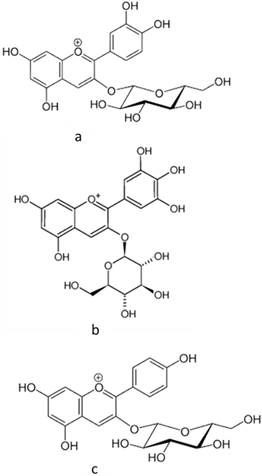 |
Anti-inflammatory, antioxidant | 0.82 ± 0.17 a 12.67 ± 0.63 mg/100 g (pulp) and 44.3865 ± 1.3125 mg/100 g (peel) |
| [20][21][22][23] | Ascorbic acid | Peel and pulp |  |
Antioxidant, anti-cancer, anti-diabetic, anti-lipidemic | 2.94 ± 1.1 a 5.64 ± 0.7 mg/100 g (pulp) and 175 ± 15.7 µmol Trolox equivalents antioxidant capacity (TEAC)/g (peel) |
| [23][24] | Betacyanin | Peel and pulp | 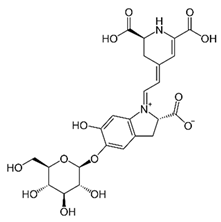 |
Anti-microbial, anti-viral, pigments, hypolipidemic | 10.3 ± 0.22 a 82.79 ± 0.55 (pulp) and 13.8 ± 0.85 a 18.67 ± 0.50 mg/100 g (peel) |
| [25][26] | Lycopene | Pulp | 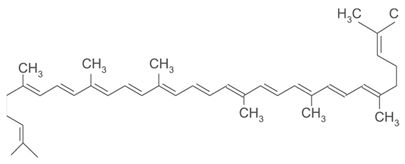 |
Antioxidant, anti-diabetic, anti-cancer | 3.2 ± 0.6 µg/100 g (pulp) |
| [20][26][27] | β-carotene | Pulp |  |
Antioxidant, anti-diabetic, anti-cardiovascular diseases | 209.1 ± 0.1 µg/100 g (pulp) |
| [28][29] | Tocopherol | Seed |  |
Antioxidant, anti-cancer, anti-diabetes, anti-cardiovascular diseases | 150 µg/100 g (seed) |
| [20][30] | p-Coumaric acid | Pulp and seed |  |
Antioxidant, anti-diabetic, anti-lipidemic | 0.365 a 1.52 ± 1,4 mg/100 g (seed) and 0.16 mg 100 g (pulp) |
| [23][28][31][32] | Gallic acid | Peel, pulp, and seed | 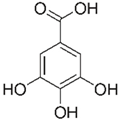 |
Antioxidant, anti-diabetic, anti-obesity | 24.0 ± 2.7 a 53.2 ± 6.2 mg GAE/100 g (pulp), 39.9 mg GAE/100 g (peel)and 375.1 mg GAE/100 g (seed) |
| [20][33] | Syringic acid | Peel, pulp, and seed |  |
Antioxidant, anti-diabetes, anti-cardiovascular diseases, anti-cancer | Variando de 0.095 a 65.10 ± 0.04 µg/100 g (peel and pulp) Seed (NA) |
| [23][34][35] | Vanillic acid | Peel and pulp | 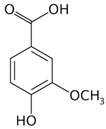 |
Antioxidant, anti-inflammatory, anti-diabetic, anti-proliferative, and anti-atherogenic activities | 0.64 mg/100 g (peel and pulp) |
| [20] | Phthalic acid | Peel |  |
Antioxidant | (NA) |
| [36] | Benzoic acids derivatives: salicylic acid (a), 3- hydroxyl benzoic acid (b), 4-hydroxy benzoic acid (c). |
Peel and Pulp | 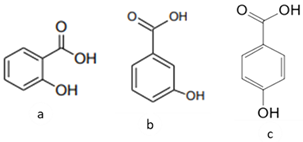 |
Antioxidant | Variando de 0.48 ± 0.0 a 11.97 ± 0.8 µg/100 g (pulp and peel) |
| [20][23][37] | Caffeic acid | Peel and seed |  |
Antioxidant | 0.08 mg/100 g (pulp and peel) |
| [18][38] | Quercetin | Peel and pulp | 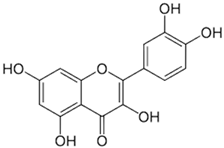 |
Antioxidant, anti-inflammatory, anti-diabetic | 3.43 mg/100 g (pulp) Peel (NA) |
| [22][39][40][41][42] | Fatty acids: oleic acid (a), linoleic acid (b), linolenic acid (c), and palmitic acid (d) |
Pulp and seeds | 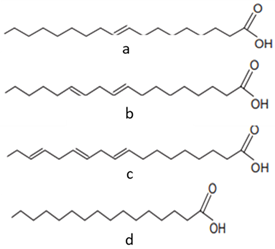 |
Nutraceutical activity | 129.11 (a), 252.65 (b), 5.33 (c), 62.74 (d) mg/100 g (pulp) and 60 (a), 21 (c), 13 (d) g/100 g (seeds) |

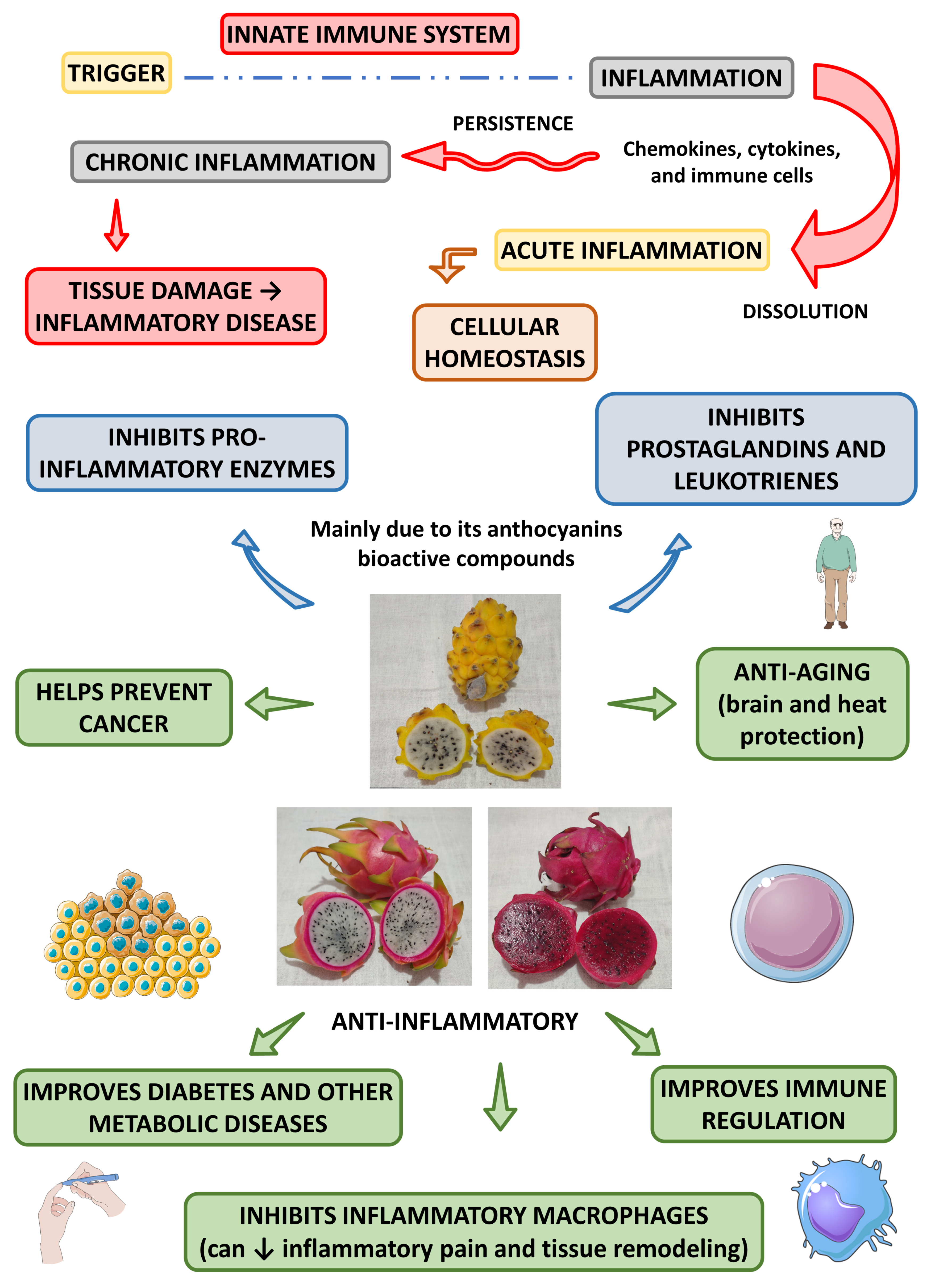
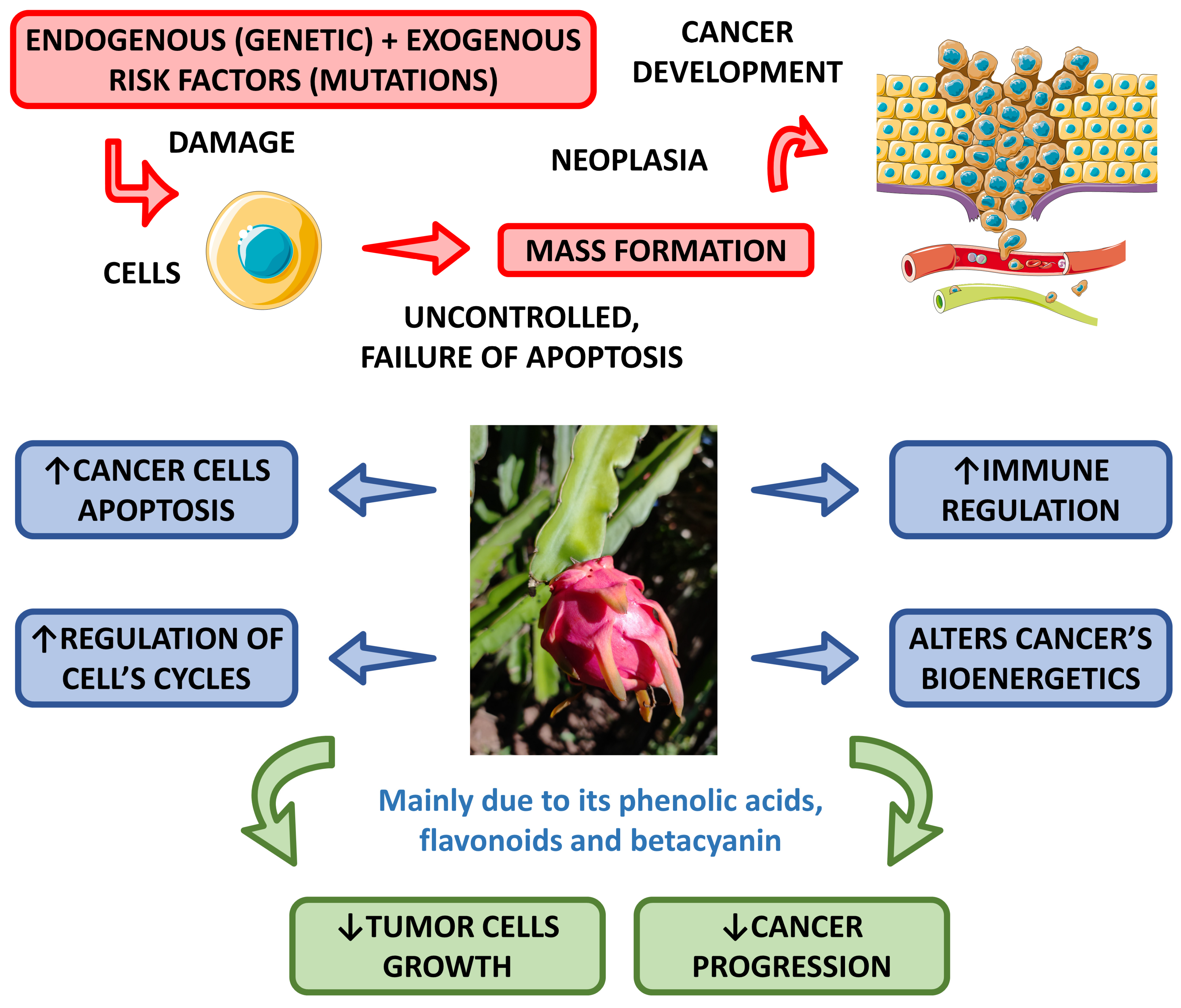

| Properties | Plant Part Used or Compounds | Species | Models | Type of Extract | Tested Concentrations | Methods | Observations | References |
|---|---|---|---|---|---|---|---|---|
| Anti-glycation | Freeze-dried powder rich in phenolic bioactive compounds. | H. polyrhizus. | Bovine serum albumin. | Ethanolic, hydro-ethanolic, methanolic, hydro-methanolic, acetone, aqueous, and petroleum ether extracts. | Concentrations range from 20 µg/mL to 100 µg/mL. | Glycation and aggregation of protein assays, carbohydrate cleaving enzyme inhibitory activity assessments, antioxidant studies, and determination of fructosamine inhibition. | Methanolic and acetone extracts were the most significant anti-glycation and antioxidant agents. The potential polyphenolic compounds associated with these effects were mainly 4-prenylresveratrol, vicenin, and luteolin. | [67] |
| Leaves rich in triterpenes. | H. undatus. | Bovine serum albumin. | Chloroform extract. | 0.5–2.0 mg·mL−1, 3 mmol·L−1, and 5 mmol·L−1. | Protein glycation and aggregation assessments. | The studied triterpenes could inhibit protein glycation at multiple stages, decreasing protein oxidation and protecting against diabetic-related complications. | [68] | |
| Anti-diabetic | Bulb and peel. | H. undatus. | Dipeptidyl peptidase-IV enzyme. | Ethanolic and hydro- ethanolic extracts of pitaya’s fruit and ethanolic extract of pitaya’s peel. | 10 mg/100 µL. | In vitro dipeptidyl peptidase-IV enzyme inhibition. |
The hydro-ethanolic extract of pitaya’s fruit exerted 26.8 ± 0.55% of DPP-IV inhibition, the ethanolic extract of pitaya’s peel exerted 62.3 ± 0.63%, and the ethanolic extract of pitaya’s fruit exerted 84.2 ± 0.72%. | [69] |
| Anti-plasmodium | Peel. | H. polyrhizus. | Plasmodium falciparum 3D7 and W2 strains, HeLa cells, and SK-OV-3 cells. | Pigmented, n-hexane, dichloromethane, and ethyl acetate extracts. | - | Anti-plasmodium and cytotoxicity assays. | The dichloromethane extract demonstrated the most prominent anti-plasmodium activity at concentrations of 2.13 ± 0.42 µg/mL. The extracts showed cytotoxicity against the cancer cells at final concentrations of more than 1000 µg/mL. | [70] |
| Cytotoxicity | Pulp and peel rich in maltotriose, quercetin-3-O-hexoside, and betalains bioactive compounds. | H. polyrhizus. | Vero cell lines. | Ethanolic and aqueous extracts. | - | Cytotoxicity assays. | The toxicity against the cells ranged from 2.18 to 2.36 mg/mL for the peel and pulp. | [5] |
| Peel. | H. polyrhizus and H. undatus. | PC3, Bcap-37, and MGC-803 cell lines. | Supercritical carbon dioxide extracts. | Maximum concentrations of 0.7 mg/mL. | Cytotoxicity assays. | All extracts demonstrated significant cytotoxicity against the cancer cell lines at concentrations ranging from 0.61 to 0.73 mg/mL. | [71] | |
| Hepatoprotective | Peel rich in betacyanins. | H. undatus. | HepG2 cells. | Pressurized in the hot water extract. | Concentrations range from 20 μg/mL to 100 μg/mL. | Measurements of ROS and lipid accumulation, as well as biochemical tests. | The betacyanin-rich extracts could effectively exert antioxidant and hepatoprotective effects in the treated cells by controlling their lipid metabolisms and diminishing their TG contents. These compounds inhibited the liberation of the liver enzymes AST and ALT and probably regulated the mRNA expressions of the fatty acid synthase and carnitine palmitoyl transferase 1. | [72] |
| Anti-viral | Pulp rich in betacyanins. | H. polyrhizus. | Denv-2 strains and Vero cells. | Methanolic extracts. | Maximum concentrations at 4.346 mg·mL−1. | Cytotoxicity and anti-viral assays. | The extract was considered non-toxic for the cells at concentrations below 2.50 mg·mL−1. The most prominent anti-viral potential (95.0% virus inhibition) against the denv-2 was achieved at concentrations of 126.70 μg mL−1. | [73] |
| Immunomodulatory | Peel rich in the terpenoid lupeol. | H. polyrhizus. | Mice macrophages. | The compound was dry isolated. | 100, 50, 25, 12.5 and 6.25 µg/mL. |
Phagocytosis assessments and other macrophagic tests. | The terpenoid lupeol isolated from the mice was effectively associated with the increase of macrophage phagocytosis of latex beads, demonstrating potent immunomodulatory effects. | [74] |
| Bone effects | Fruit extract. | H. polyrhizus. | Bone marrow-derived mesenchymal stem cells. | Aqueous. | 50, 100, 200, 300, and 400 µg/mL. | Cells osteogenic and proliferation assessments. | The fruit extract could promote the osteogenic differentiation and proliferation of the treated cells. | [75] |
| Reference | Local | Model and Patients | Intervention | Outcomes | Adverse Effects |
|---|---|---|---|---|---|
| [76] | United Kingdom | Randomized, double-blind, placebo-controlled, cross-over trial with 19 healthy subjects (8 ♂, 11 ♀; 18–40 y) | Participants consumed 24 g of whole dragon fruit powder (33 mg of betalains) or a placebo daily/for 14 days. Blood pressure, Flow-mediated dilation (FMD), and arterial stiffness were evaluated (0, 1, 2, 3, and 4 h and 14 days after daily consumption). | Pitaya consumption significantly improved acute FMD at 2, 3, and 4 h post-consumption compared with placebo. This was also observed until 14 d. Pulse wave velocity was acutely significantly decreased at 3 h, and the augmentation index improved after 14 days compared with the placebo. No significant differences were observed for BP. | Not reported by patients. |
| [64] | Indonesia | Quantitative research type quasi-experiment (pre-test and post-test nonequivalent control group) with 32 students (4 ♂, 28 ♀; 21–26 y) who presented excess nutritional status. | Participants consumed 180 g of red pitaya/7 days. | The consumption of dragon fruit effectively reduced glycemia and blood pressure in subjects with excess nutritional status. | Not reported by the authors. |
| [61] | Malaysia | Randomized trial with 28 subjects (14 ♂, 14 ♀, 21 with type 2 diabetes; 20–55 y) | Participants were divided into 4 groups: 400 g of red pitaya/d, 600 g of red pitaya/d, negative control (diabetic subjects with normal diet), and the last group (healthy subjects with normal diet)/7 w. The study included 4 weeks of treatment and 2 weeks of wash-out. | After 4w: Group 1 showed a significant increase in HDL-c and a significant reduction of glycemia, LDL-c, and triglyceride. There was a significant augment of total cholesterol level on 7th w. No significant modifications were seen in group 2. No significant modifications were seen in weight and body fat in any group. | Not reported |
| [43] | Malaysia | Single-blinded cross-over trial with 36 Pre-diabetic participants | Pre-diabetic participants received 60, 80 or 100 g of spray pitaya (red) powder daily/4 week. | A significant decrease was seen in glycemia, total cholesterol, LDL-c, and triglycerides. A significant increase in HDL-c and total antioxidant status was observed. | Not reported |
| [44] | Malaysia | Single-blinded cross-over trial with 60 normocholesterolemic subjects | Participants were divided to receive 3, 4 or 5 sachets of spray pitaya (red) powder (20 g each) daily/4 weeks. | Significant reduction in glycemia, total cholesterol, LDL-c, and triglycerides. A significant increase in HDL-c and total antioxidant status. | Not reported by the participants. |
| Study | Question Focus | Appropriate Randomization | Allocation Blinding | Double-Blind | Losses (<20%) |
Prognostics or Demographic Characteristics |
Outcomes | Intention to Treat Analysis | Sample Calculation | Adequate Follow-Up |
|---|---|---|---|---|---|---|---|---|---|---|
| [76] | Yes | Yes | Yes | Yes | Yes | Yes | Yes | NR | NR | Yes |
| [64] | Yes | No | No | No | NR | Yes | Yes | NR | NR | No |
| [61] | Yes | No | NR | NR | NR | Yes | Yes | No | No | Yes |
| [43] | Yes | No | Yes | No | NR | No | Yes | No | No | Yes |
| [44] | Yes | No | Yes | No | NR | No | Yes | No | No | Yes |